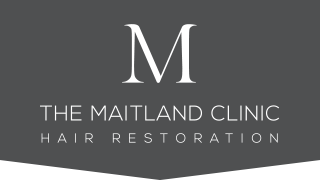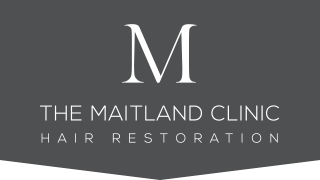CQC Inspection Report
9th November 2018
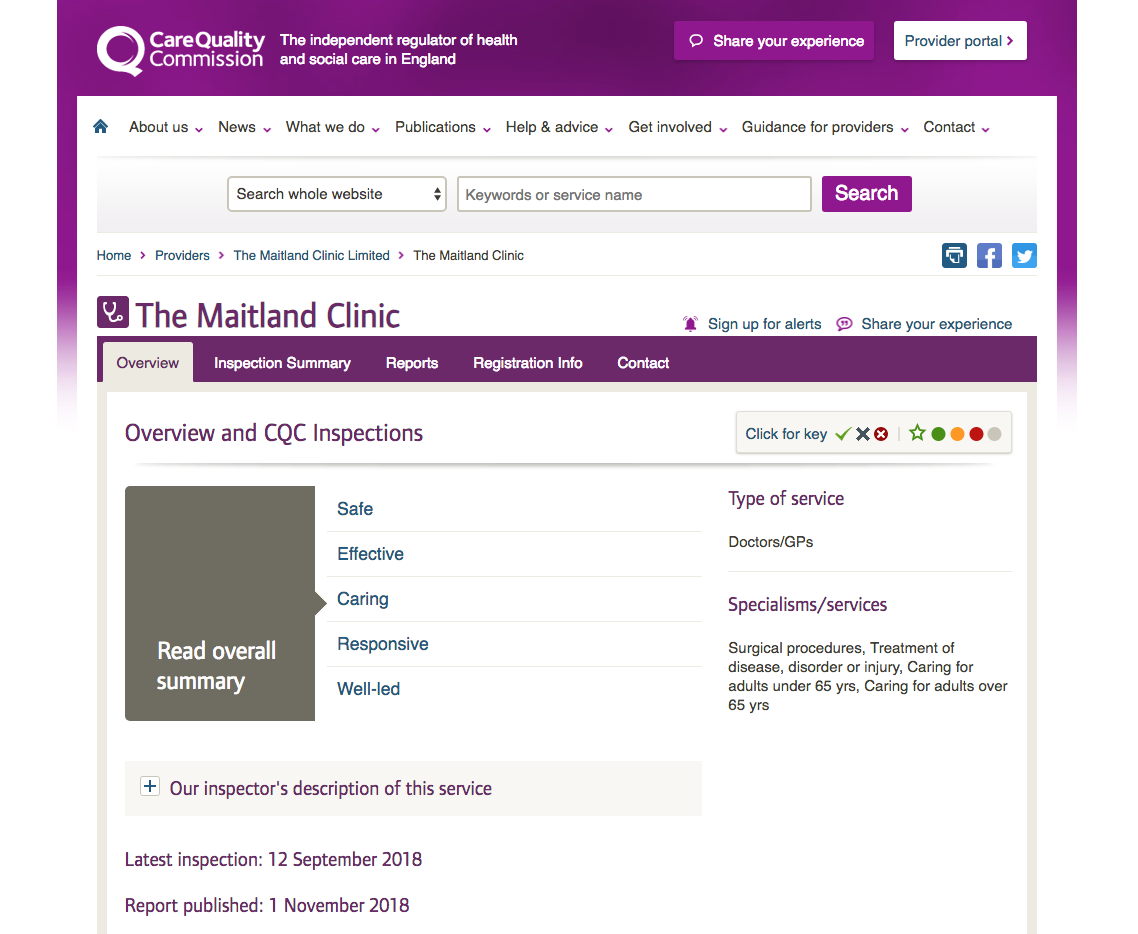
At The Maitland Clinic, we have recently had our routine inspection from the Care Quality Commission. The inspector was impressed and suggested that we should proudly share our report. You can read their summary below or go to CQC’s website to read and download the full report.
The Maitland Clinic Limited – Inspection report
Overall Summary
We carried out an announced comprehensive inspection of The Maitland Clinic on 12 September 2018 to ask the service provider the following key questions; Are services safe, effective, caring, responsive and well-led?
Our findings were:
Are services safe?
We found that this service was providing safe care in accordance with the relevant regulations. Are services effective? We found that this service was providing effective care in accordance with the relevant regulations
Are services caring?
We found that this service was providing caring services in accordance with the relevant regulations
Are services responsive?
We found that this service was providing responsive care in accordance with the relevant regulations
Are services well-led?
We found that this service was providing well-led care in accordance with the relevant regulations. We carried out this inspection under Section 60 of the Health and Social Care Act 2008 as part of our regulatory functions.
This inspection was planned to check whether the service was meeting the legal requirements and regulations associated with the Health and Social Care Act 2008. This service is registered with CQC under the Health and Social Care Act 2008 in respect of some, but not all, of the services it provides.
There are some exemptions from regulation by CQC which relate to particular types of service and these are set out in Schedule 2 of The Health and Social Care Act 2008 (Regulated Activities) Regulations 2014.
This hair transplant service for adults is registered with CQC under the Health and Social Care Act 2008 in respect of the provision of minor surgery and treatment of disease, disorder or injury.. We received 26 Care Quality Commission comment cards. These were all positive regarding the environment, provider, staff, efficiency and effectiveness of service, care delivered and the caring attitude of the provider. Many stated that the service was sensitive, non-pushy, professional, and that the staff took the time to explain the process to them. They found the provider professional and would recommend the service to others.
Our key findings were:
- The hair transplant service was offered on a private, fee paying basis and was accessible to people who chose to use it.
- Procedures were safely managed and there were effective levels of patient support before, during and after the service.
- The service had systems in place to identify, investigate and learn from incidents relating to the safety of patients and staff members.
- There were systems, processes and practices in place to safeguard patients from abuse.
- Information for service users was comprehensive and accessible. Staff had the relevant skills, knowledge and experience to deliver the care and treatment offered by the service.
- The service had processes in place to securely share relevant information with others such as the patient’s GP, pharmacists, NHS organisations and when required, safeguarding bodies and private healthcare facilities.
- The service encouraged and valued feedback from service users via in-house surveys and the website. There were areas where the provider should make improvements:
- Review how information is gathered during follow up of surgical outcomes for patients to monitor any trends that might arise.
The Maitland Clinic Details Findings
Background to this inspection
We carried out this inspection on 12 September 2018. The inspection team consisted of a lead CQC inspector and a GP Specialist Advisor.
As part of the preparation for the inspection, we reviewed information provided for us by the service. In addition; we reviewed the information we held on our records regarding this provider.
During the inspection we utilised a number of methods to support our judgement of the services provided. For example, we toured the building, interviewed the providers and staff, looked at the clinical systems and patient records and reviewed documents relating to the service.
The Maitland Clinic provides a private hair transplant advice and surgical service to adults.
The service operates from: The Maitland Clinic1000 Lakeside North Harbour, Western Road, Portsmouth, PO6 3EN.
Patients can also be seen within private consultation offices rented on an ad hoc basis in London. These offices were not inspected during this inspection.
The business has been in operation since 2016. The premises are situated in Portsmouth within a large shared building. There is a shared reception and accessible facilities for any patient with mobility issues. For example, there are ramps and level floor surfaces. There is a shared reception area where patients are met and taken through to a private waiting room. Because of the sensitive nature of the business there are also alternative exits to the rear of the building for additional privacy of the service. The provider does not have overall responsibility for maintaining the building but obtains assurances of maintenance. For example, fire safety, waste management and maintenance.
The service is led by a doctor who has experience in plastic surgery, dermatology, and being an NHS GP partner. The provider has a qualification in the American Board of Hair Restoration surgery. He is also an examiner for this type of surgery. He is supported by a team of five staff; a business partner/lead hair technician, patient advisor, nurse specialist, hair technician and receptionist/administrator. The provider employed additional hair technicians as required.
The clinic operates weekly from 9am to 6pm Monday to Friday. To get to the heart of patients’ experiences of care and treatment, we always ask the following five questions:
• Is it safe?
• Is it effective?
• Is it caring?
• Is it responsive to people’s needs?
• Is it well-led?
These questions therefore formed the framework for the areas we looked at during the inspection.
Are Services Safe?
Our findings
Safety systems and processes
The service had systems, processes and practices in place to minimise risks to patient safety.
• Arrangements for safeguarding reflected relevant legislation and local requirements. The service had a safeguarding lead. Policies and protocols had been developed which covered safeguarding, whistleblowing, management of disclosure and referral. The policies clearly outlined processes to be adhered to.
• We saw evidence that staff were up to date with all professional training requirements. We saw that records of required training were kept and were informed that clinicians also undertook self-directed learning to support their own professional development. All staff were encouraged to attend updates in the specialist field and had all attended an overseas conference.
• We spoke with staff regarding their recruitment process. These staff told us they had been interviewed, asked for proof of identification, an employment history, medical information and had given the names of two references.
• The provider had a policy of completing a Disclosure and Barring Service (DBS) check for all staff. (DBS checks identify whether a person has a criminal record or is on an official list of people barred from working in roles where they may have contact with children or persons who may be vulnerable).
• All staff had received training on safeguarding children and vulnerable people relevant to their role. For example, the doctor had been trained to child protection or child safeguarding level three and additional staff to level two.
• The provider maintained appropriate standards of cleanliness and hygiene. Patients commented that the practice appeared hygienic and clean. Cleaning schedules were in place in all clinical areas. Systems were in place to return surgical equipment to central sterilising services and tracking was in place to trace this equipment. Single use equipment was also used. Protective personal equipment and cleaning equipment was readily available and used.
• There were infection control procedures in place to reduce the risk and spread of infection. The last overall infection control audit was performed this month. Hand hygiene audits and sharps bins audits had also been completed. The nurse specialist said she did routine safety and environmental checks before each surgical treatment took place. We inspected the consultation rooms, theatre areas and waiting areas which all appeared clean and were in good overall condition.
• Appropriate systems were in place for clinical waste disposal. Risk assessments were seen for clinical waste and clinical sharps.
• Systems were in place for the prevention and detection of fire. Risk assessments and equipment was readily available.
• General environmental risk assessments were completed monthly. The latest assessment had resulted in staff being given copies of data sheets for chemicals used, (Control of Substances Hazardous to Health-COSHH), to ensure safe use of these chemicals.
Risks to patients
The clinic had arrangements in place to respond to emergencies and major incidents.
• All staff had received basic life support training.
• The service had a defibrillator, oxygen and emergency equipment on the premises which clinical knew how to use. Emergency alarms and panic buttons were situated in theatre areas and reception areas. A first aid kit was also available on-site.
• Emergency medicines were safely stored, and were accessible to staff. We saw that the emergency medicine stock included medicines used for the emergency treatment of allergic reactions and/or complications from surgery.
• All electrical equipment had been checked to ensure it was safe to use.
• Clinical equipment was new and checked regularly to ensure it was working properly. Systems were in place to ensure this equipment been calibrated.
• Clinical rooms storing medical gases were appropriately signed
• The provider was made aware of any issues which could adversely impact on health and safety. Staff from the clinic were aware of evacuation procedures and routes. The building landlord had provided a continuity plan to inform tenants what to do in the event of emergency or power failure.
The provider had employer’s liability insurance cover and clinicians had medical indemnity insurance in place. All doctors were registered with the GMC and the nurse was on the NMC register.
Information to deliver safe care and treatment
The providers and staff worked with other services when this was necessary and appropriate, and spoke with patients GPs and other healthcare providers.
Comprehensive pre operative assessments were completed, including full medical history, medicine usage, allergies and surgical safety checks. Any issues were discussed with other healthcare professionals as appropriate.
The provider told us approximately 30-50% of all patients were advised that hair transplant surgery was unsuitable and were signposted to other providers; for example, back to the GP or pharmacy for medicines advice. Where patients were referred to other healthcare providers written records were kept.
The clinic had processes in place to share information with safeguarding bodies when required.
Safe and appropriate use of medicines
The arrangements for managing medicines, including emergency medicines in the service minimised risks to patient safety (including obtaining, recording, handling, storing, security and disposal).
The service did not prescribe medicines to patients. Patients were referred to the pharmacy or GP to obtain these medicines so appropriate monitoring and communication with the patient’s GP could take place. However some pain relief and anti-inflammatory medicines were supplied after the procedure.
Medicines kept within the clinic were checked on a regular basis and expiry dates of all medicines clearly labelled. Expiry dates of medicines and equipment were recorded on a document and computer system to show these checks had taken place.
Track record on safety
There was a system in place for reporting and recording significant events. The provider had systems and processes in place to identify, record, analyse and learn from incidents and complaints.
There had been one significant event recorded by the service. This was where a patient who had been booked for surgery was cancelled on the day of the surgery because of the donor hair area not being suitable. An apology was given to the patient and alternative treatments recommended. Action also included ensuring a second review of patients prior to the planned surgery day to re confirm suitability.
Lessons learned and improvements made
The one significant event investigated by the clinic was reviewed and investigated promptly and demonstrated the requirements of the Duty of Candour. This means that people who used services were told when they were affected by something which had gone wrong; were given an apology, and informed of any actions taken to prevent any recurrence. The provider encouraged a culture of openness and honesty. There were systems in place to deal with notifiable incidents.
Are services effective? (For example, treatment is effective)
Our findings
Effective needs assessment, care and treatment The service delivered care in line with relevant and current evidence based guidance.
Patients who used the service had an initial consultation where a detailed medical history was taken from the patient. Patients who used the service were able to access detailed information regarding the procedures which were delivered by the provider. We spoke with one patient who said there was information regarding the service on the website, YouTube and within online patient forums. Information available included advice on the procedures, pre and post-operative care. The patient we spoke with and comment cards commented that the provider and staff were informative and not pushy about treatments.
All surgical treatments followed a ‘cooling off’ period from the initial consultation enabling the patient to return at a later date for the treatment once they had made an informed decision.
Patients were given pre-operative advice and leaflets advising what to bring into theatre and what to expect following surgery. The clinic supplied patients with a post op care bag which included pain relief for the first few days and anti-inflammatory tablets for the first three days. There was also a neck pillow to encourage patients to sleep raised for the first six nights to avoid contact with the grafted area. Petroleum jelly was also supplied to apply to the donor area for the first six days as well as a spray to promote growth and keep the area moist. Pillow protectors were also provided to keep bed linen clean during this initial post-operative phase. After the procedure the staff discussed after care treatment again with patients and sought to inform them of what to expect over the recovery period. This was both to allay concern and anxiety from the patients and to prevent them unnecessarily attending other primary or secondary care services. Patients were encouraged to contact the staff during the recovery period and were given mobile telephone numbers of the provider or business partner. These staff said calls were usually to ask about practical issues such as wearing hats rather than complications.
The provider was aware of evidence based guidance, and had access to written guidance should this be required, and stated that NICE (National Institute for Health andCare) guidance was available for hair transplant surgery. The provider told us the patient demographic were mostly fit and healthy but was also aware of identifying the symptoms of the acutely unwell patient. For example, anaphylaxis and sepsis.
Staff received safety alerts from the Medicines and Healthcare Products Regulatory Agency (MHRA) and cascaded this to the staff team through team meetings and their email system.
Monitoring care and treatment
The provider kept a record of each procedure conducted in theatre and had processes in place to capture medicine usage, equipment used and the type of surgery. Patients were given comprehensive details of what complications may arise and what to look for. Details of contact details were given and instructions to contact the service at any time should any complications or questions arise. Patients were also monitored following the surgery.
Effective staffing
The service was led by a doctor with a career history of plastic surgery, dermatology, NHS GP, cosmetic medicine and surgery. He holds a number of memberships and qualifications including:
• Member of the Royal College of Surgeons.
• Diplomate of American Board of hair restoration surgery.
• Member of International and British society of hair restoration surgery.
• Associate member of British College of Aesthetic Medicine.
• Member of Royal College of GPs.
• Diploma in practical dermatology.
• Member of the British Medical Association and
• Bachelor of Medical sciences and bachelor of Surgery.
The team consists of five staff; a business partner/lead hair technician, patient advisor, nurse specialist, hair technician and receptionist/administrator. The provider employed additional hair technicians as required.
All medical staff had medical indemnity cover and were registered on professional registers. For example, Nursing and Midwifery Council and General Medical Council. All staff had training records and had completed the provider’s mandatory training in subjects including basic life support, safeguarding and fire safety.
Each staff member had an annual appraisal where training needs were identified, although staff said training needs could be identified informally throughout the year or more formally at staff meetings.
The provider placed an emphasis on education and learning and encouraged this throughout the team. The whole team had attended the International Society of Hair Restoration Surgery annual conference in October 2017. The provider had attended a CQC Registered Manager training day and the receptionist had attended a medical receptionist course.
Coordinating patient care and information sharing
We were given examples of working with other services and saw that the provider did so when necessary and appropriate. For example, the provider liaised with patients GPs and other healthcare providers as required.
The medical staff asked for consent to contact the patients GP at the initial consultation and did so where appropriate.
Consent to care and treatment
We found that staff sought patients’ consent to care and treatment in line with legislation and guidance.
• The provider had developed protocols and procedures to ensure that consent for procedures and treatment were obtained and documented. Consent forms were bespoke to hair transplant surgery and contained benefits and risks associated with the procedure.
• Consent was obtained for the use and retention of medical photographs
• The provider understood the relevant consent and decision-making requirements of legislation and guidance, including the Mental Capacity Act 2005.
Are services caring?
Our findings
Kindness, respect and compassion
Comment cards and internal and external surveys contained comments to demonstrate that the patients were happy with the care, treatment and service received. Patient comments included feedback that the staff were courteous, caring and helpful to patients and treated them with dignity and respect.
Involvement in decisions about care and treatment
Feedback from comment cards showed that patients had been involved in the decision making process. The medical staff actively discussed the procedure with patients and recorded discussion in the patient record. We gained evidence of this on the day of inspection.
The provider made extensive use of patient feedback as a measure to monitor and improve services and did this by monitoring compliments, complaints and results from patient surveys.
Privacy and Dignity
Doors were closed during consultations and conversations taking place in these rooms could not be overheard. Equipment was available in theatre areas to protect the privacy and dignity of patients when surgery was taking place. There was an exit to the rear of the clinic to allow patients to arrive and leave the premises more discreetly should this be required. For example, patients in the public eye.
The provider told us that staff spent time with patients both pre-and post procedure carefully explaining the after care, recovery process and options to reduce any anxieties patients may have.
Staff used written information and resources for patients that they could take away with them to refer to at a later time.
Are services responsive to people’s needs? (for example, to feedback?)
Our Findings
We found that this service was providing responsive services in accordance with the relevant regulations.
Responding to and meeting people’s needs
The provider demonstrated to us on the day of inspection they understood their patients and had used this understanding to meet their needs:
• The provider had a range of information and support resources which were available to patients.
The website for the service was very clear and easily understood. In addition, it contained useful information regarding treatment and procedures available, fees payable, procedures and aftercare.
• The provider and patient advisor were experienced in the area of hair loss transplant surgery services and were able to signpost patients unsuitable for surgery to other service types.
• The provider aimed to provide a patient-focused service. This provided one surgical patient a day, doctor contact from day one onwards, mobile contact details of the doctor and business partner and 24/7 support before and after surgery.
Timely access to the service
The service operated between Monday and Friday depending on patient demand. Appointments were available between 9am and 6pm. Enquiries could be made by telephone or by using the website. Surgery took place four days a week with one patient being seen per day for surgery due to the length of surgery time.
The clinic offered appointments to anyone who requested one and did not discriminate against any client group. The offered a service to male, female and transgender patients from across the world.
The Maitland Clinic was in a good condition of repair and was accessible to those with mobility difficulties, or those who used a wheelchair being entered via level surfaces. Patients received treatment on the second floor which could be accessed by passenger lift.
The provider told us the majority of patients used English language but added that telephone interpreting services were available if required.
Listening and learning from concerns and complaints
The provider had a complaints policy and process in place. Patients told us they did not have any complaints but knew feedback could be offered face to face or online via the website.
At the time of our inspection the provider had received no formal complaints. We saw the provider had treated patient feedback as a complaint. A patient had made a comment about staff discussing non surgical issues in the theatre environment. The patient was reassured that staff were concentrating but staff were reminded about acceptable behaviours in the company of patients.
Are services well-led? (for example, are they well-managed and do senior leaders listen, learn and take appropriate action?)
Our Findings
Leadership capacity and capability;
The service is run by five staff and is led by a doctor, business partner, patient advisor and nurse specialist. There were clear organisational responsibilities and communication was effective within the organisation. The leadership team were responsible for the organisational direction and development of the service and the business partner and nurse specialist responsible for the day to day running of the clinic. The providers were aware of their scope of competencies and services offered.
Vision and strategy
The provider had a clear vision to provide care and treatment options in response to patient demand and within their clinical competencies within a clinically-clean and safe environment. The provider also declined surgical options where appropriate and signposted patients to other sources of support. Patients were grateful for this openness and approach.
Culture
The provider had purposefully developed a small clinic with a focus on patient experience, personal, one-to-one service and contact with the doctor throughout the patient journey. The provider had created a culture and environment to attract highly skilled, happy, motivated staff, who shared his passion and enthusiasm and aimed to retain staff to develop as the clinic and service grew. The providers were aware of, and complied with, the requirements of the Duty of Candour. When unexpected or unintended safety incidents occurred, the provider gave affected patients reasonable support, truthful information and a verbal and written apology.
Governance arrangements
The service had an embedded governance framework in place and produced records to demonstrate the processes and systems being completed. For example, checks on medicines, safe surgical check lists, cleaning schedules and surgery procedures. We noted information was not always routinely gathered during follow up of surgical outcomes for patients to monitor any trends that might arise to further improve the service.
Service specific policies and protocols had been developed, implemented and reviewed and were accessible in electronic and paper formats. These included policies and protocols included:
• Consent
• Infection prevention and control
• There was an effective, process to identify, understand, monitor and address current and future risks including risks to patient safety.
• The service had processes to manage current and future performance. • The business manager had oversight of incidents, and complaints.
• The service had plans in place and had trained staff for emergencies and major incidents.
Engagement with patients, the public, staff and external partners
The provider encouraged and valued feedback from patients and staff. It proactively sought feedback from:
• Online and written feedback, thank you cards, compliments and complaints.
• Verbal feedback post procedure.
• Internal surveys
We saw many letters of thanks and records of numerous verbal thanks. The service had received one negative comment which was treated as a complaint and was responded to appropriately.
Online feedback about the service had been positive. Feedback on google showed the service had received 4.4 out of five stars in 13 reviews. Two negative reviews had been responded to by the service and thought to be errors as the provider had not treated patients identified.
We received 26 comment cards. All comments were positive and contained positive feedback regarding the facilities, staff, service, treatment and care.
The service had conducted an annual patient experience survey between February 2018 and August 2018. Of the 25 respondents:
• 24 people said they rated the information during the procedure as excellent and one as good
• 23 people rated staff as excellent at involving them in decisions
• 24 people were satisfied with the assessment of their hair loss.
Comments were complimentary about the service.
The provider encouraged staff to give feedback and offer suggestions for improvement. Staff we spoke with said they felt able to share new ideas and offer suggestions. For example, the nurse had completed an audit of patient records and had devised a new document to clearly describe and obtain patient consent.
Continuous improvement and innovation
• There was a focus on continuous learning and improvement at all levels within the service.
• All patients were reviewed following surgery. These findings were recorded in the patient records. Staff said there had been minimal complications. However, information gathered during follow up of surgical outcomes for patients was not collated to monitor any trends that should arise.
• Incidents and feedback, including complaints, were used to make improvements.
• Staff told us they were always striving to improve and focused on reflective practice and worked within an open and supportive culture. Staff added that they spoke with each other daily and communication about changes within the industry were effective methods of driving change.
